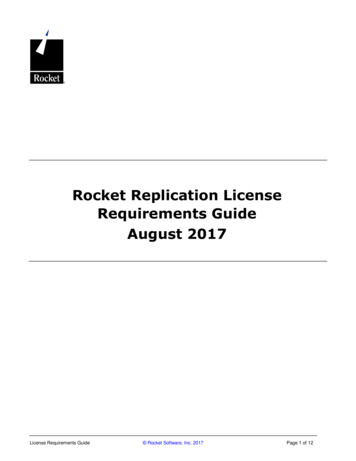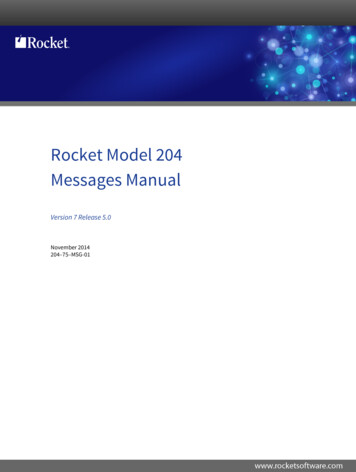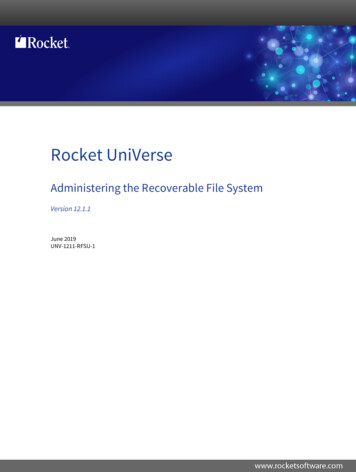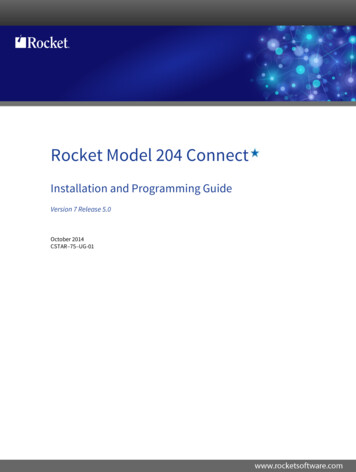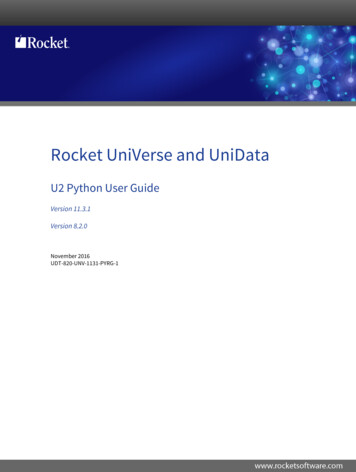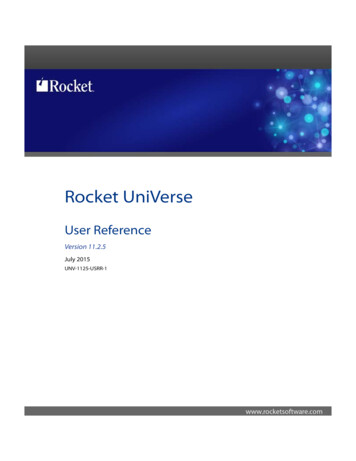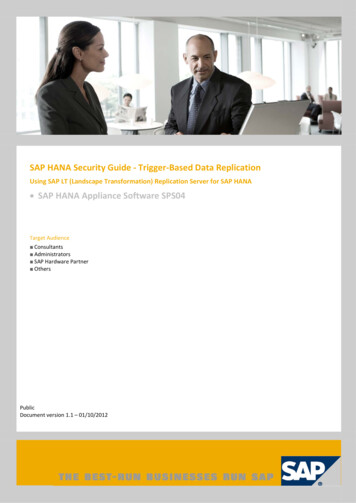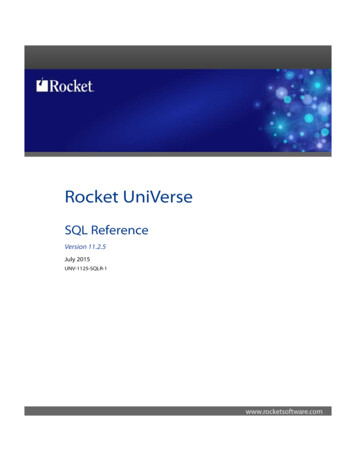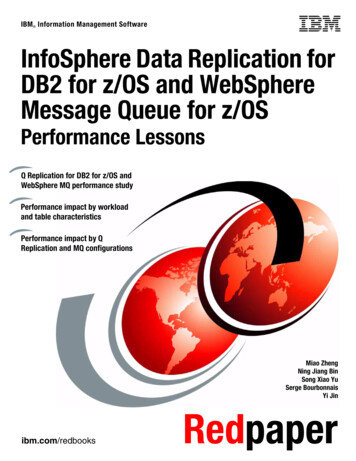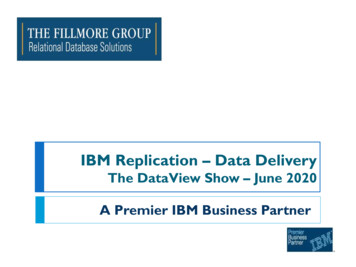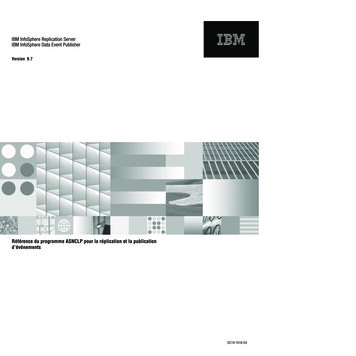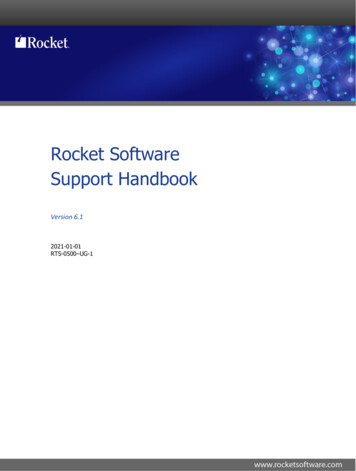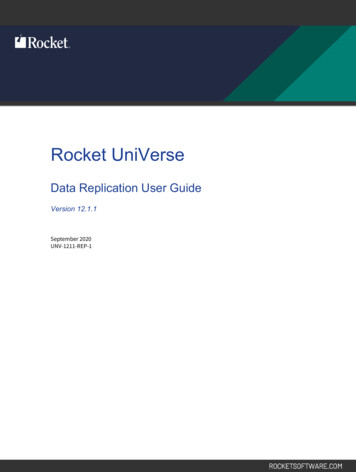
Transcription
Rocket UniVerseData Replication User GuideVersion 12.1.1September 2020UNV-1211-REP-1
NoticesEditionPublication date: September 2020Book number: UNV-1211-REP-1Product version: Version 12.1.1Copyright Rocket Software, Inc. or its affiliates 1985–2020. All Rights Reserved.TrademarksRocket is a registered trademark of Rocket Software, Inc. For a list of Rocket registered trademarks goto: www.rocketsoftware.com/about/legal. All other products or services mentioned in this documentmay be covered by the trademarks, service marks, or product names of their respective owners.ExamplesThis information might contain examples of data and reports. The examples include the names ofindividuals, companies, brands, and products. All of these names are fictitious and any similarity tothe names and addresses used by an actual business enterprise is entirely coincidental.License agreementThis software and the associated documentation are proprietary and confidential to Rocket Software,Inc. or its affiliates, are furnished under license, and may be used and copied only in accordance withthe terms of such license.Note: This product may contain encryption technology. Many countries prohibit or restrict theuse, import, or export of encryption technologies, and current use, import, and export regulationsshould be followed when exporting this product.2
Corporate informationRocket Software, Inc. develops enterprise infrastructure products in four key areas: storage, networks,and compliance; database servers and tools; business information and analytics; and applicationdevelopment, integration, and modernization.Website: www.rocketsoftware.comRocket Global Headquarters77 4th Avenue, Suite 100Waltham, MA 02451-1468USATo contact Rocket Software by telephone for any reason, including obtaining pre-sales informationand technical support, use one of the following telephone numbers.CountryToll-free telephone numberUnited 295Japan0800-170-5464Netherlands0-800-022-2961New Zealand0800-003210South Africa0-800-980-818United Kingdom0800-520-0439Contacting Technical SupportThe Rocket Community is the primary method of obtaining support. If you have current support andmaintenance agreements with Rocket Software, you can access the Rocket Community and reporta problem, download an update, or read answers to FAQs. To log in to the Rocket Community or torequest a Rocket Community account, go to www.rocketsoftware.com/support.In addition to using the Rocket Community to obtain support, you can use one of the telephonenumbers that are listed above or send an email to support@rocketsoftware.com.3
ContentsNotices. 2Corporate information. 3Chapter 1: Introduction and terminology.9Replication and the Recoverable File System (RFS). 11Replication topologies.11One publisher and one subscriber. 11One publisher and two subscribers. 12Multi-way replication.13External Database Access (EDA) replication. 14Terminology. 17Performance.17Replication objects. 18Replication object.18Publishing object. 18Subscribing object. 18Replication system. 18Replication group. 19Group distribution. 19Replication. 19Types of replication.20Disabling replication.20Replication logs disk percentage. 21Defining replication servers. 21Defining replication groups. 21Data link compression.21Field-level replication.22Replication pacing. 22Replication pacing criteria and weight. 22Session priority level. 23Replication pacing level calculation. 24Replication logs. 24Replication log files. 25Replication buffer. 25Replication buffer extension file. 25Replication log reserve file. 25Replication subpacket store. 26System-level replication log files. 26Group-level replication log files. 26Replication log examples.28Manually deleting replication log files. 30Replication messages.30Cross-group transaction.31Transaction control record. 33Transaction control area.33Processes.33Replication manager daemon (uvrepmanager). 33Publisher process. 34Publisher listener process.34Publisher-syncing process. 34Subscriber process. 34Replication writer process. 354
ContentsReplication processes on a publishing server. 35Replication processes on a subscribing server. 36IPC structures.37Message queues.37Semaphores. 37Shared memory. 38Network. 39 UVHOME logs and errlogs. 40Chapter 2: Installing and configuring Data Replication for UniVerse. 42Files created by the installation process. 42Setting up replication.42Compatibility with previous UniVerse releases. 42Preparing to configure replication. 43Setting up replication configuration files. 43uvconfig file.44uvconfig parameters.44Replication server definition.48Example. 52Replication configuration file. 52Configuration phrases. 59Replication writer configuration phrases. 61Replication configuration (repconfig) file example.62Example default account level replication file. 64Server account file.65Configuring login credentials.65Configuring replication.65Essential tuning. 66Reviewing the number of objects in replication groups using XAdmin. 68Reviewing the number of objects in a replication group using the uvreptool utility. 68Recommended configuration and tuning.68Going live.70Chapter 3: uv repadmin tool.71uv repadmin targets. 71suspend option. 72sync option.74failover option.77reconfig option.79reset option. 83report option.84Replication status return codes. 87setconnect option.88Chapter 4: Managing Data Replication through the command line. 89Starting replication.89Example log file for starting replication and synchronizing. 91Stopping the database and replication. 94Stopping the database and replication on the publishing server.95Stopping the database and replication on the subscribing server. 96Defining publishing groups from the command line. 97Defining subscribing groups from the command line. 98Changing an existing replication group definition from the command line.98Enabling and disabling Data Replication through the command line.99Enabling and disabling Data Replication using uv repadmin. 99Disabling Data Replication.100Replication exception action programs.101Sample EXCEPTION ACTION scripts. 1015
ContentsReconfiguring live systems. 101Moving files to other replication groups.102Changing the numbers of replication writers.103Resizing a replicated file on a subscribing server. 103Resizing subscribing servers. 103Listing replication files. 104Refreshing the subscriber database.105Error handling. 106Monitoring Data Replication through the command line.106Monitoring replication with REPLOGGER.106Monitoring replication with the Windows resource monitoring tool. 108Checking re
Rocket UniVerse Data Replication User Gu
